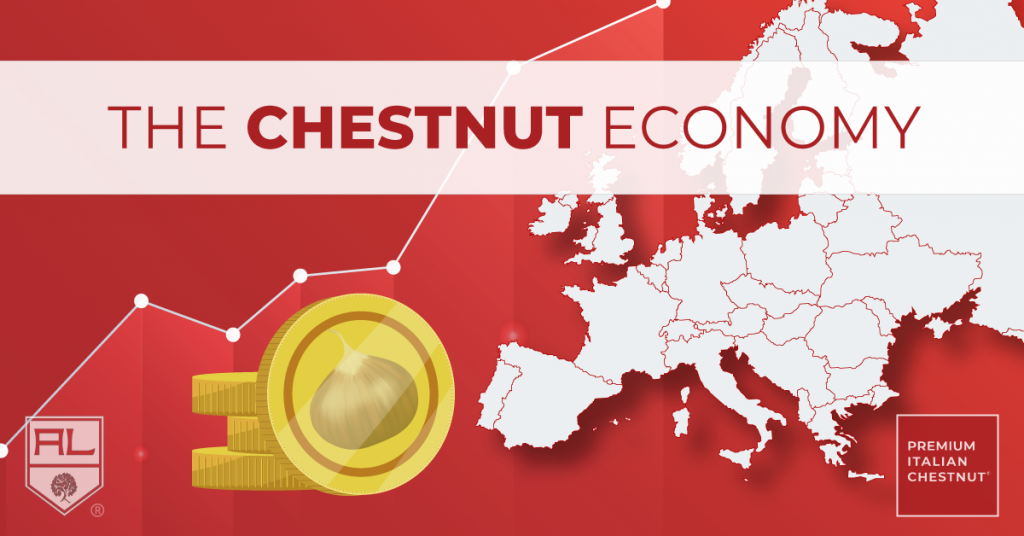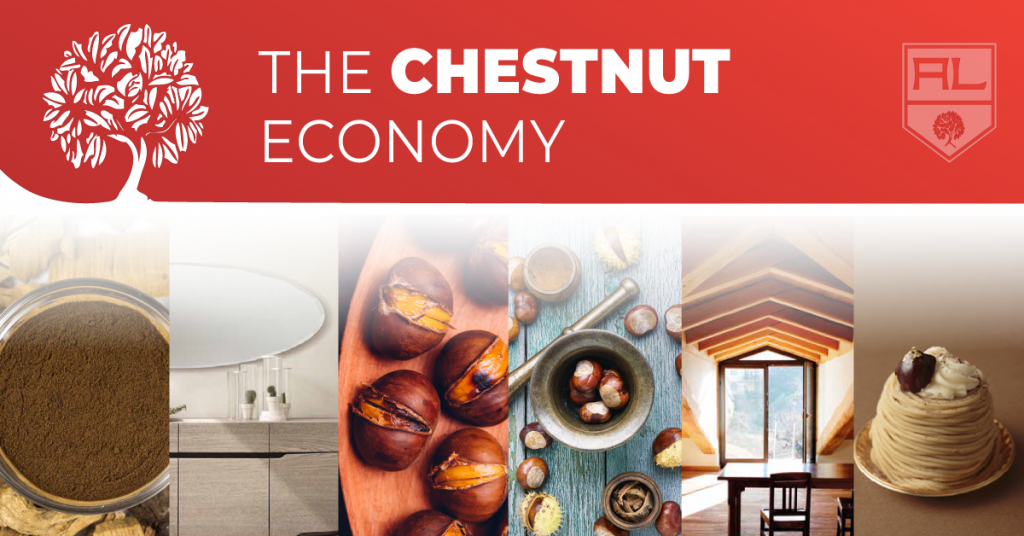
MARKET PRODUCT OF CHESTNUT
How many products can we get from Chestnut trees?
The answer is not so obvious because we may generally think almost exclusively of chestnut fruits for food use, but actually we can use these plants for other several applications thanks to different products we can obtain from them.
The Market, globally speaking, looks mainly to the sectors of gastronomy and green building. However we can identify other products from this amazing resource and different purposes that together represent an important share of the international economy.
Today, the European panorama shows a production of about 150,000 tons and 2.5 million cultivated hectares distributed mainly in the Italian, French, Spanish and Portuguese territories, with a demand that far exceeds supply. Nevertheless, Italian production is constantly growing and a 30% per year further increase is estimated over the next 5 years (data from FederLegnoArredo and EuroCastanea).
The Chestnut has always been a wealth and matter of pride from our territory with a tradition of over 2000 years. Its properties begin to be famous since the ancient Roman time, when the plant was the protagonist in the ingenious constructions and works of the “sons of Romulus”. In addition, chestnut flour itself has been an indispensable resource for centuries through which people used to produce the well-known “poor man’s bread”.
The plant with its fruits began to be so much important in everyday life that in 1367 the use of chestnut was regulated, prohibiting its cutting at the foot and establishing a ban on the use of branches as firewood. Moreover, in 1656, meticulous provisions were established even for the safeguarding of the flour mills.
Research and technology gradually led the man to consider this wood for many other different applications. Today we can affirm that each component of the plant is potentially a resource for the economy: from the roots to the leaves, from the bark to the precious wood essence. Among the various areas we find, for example, herbal medicine, gastronomy, furniture and construction.

Herbal Medicine
The numerous active ingredients included in the bark and fruits make it suitable also for medical and wellness functions. In fact, we find elements such as alkaloids, albumin, rubber, resin, small amounts of phytosterols and, above all, tannin (read the in-depth article The Superpowers of Tannin to learn about the benefits of this substance). Thanks to those elements, which are mainly present in the cortex, great benefits can be obtained in case of specific diseases such as gastric disorders, skin discomfort, colds and breathing difficulties.
The preparation of infusions with chestnut leaves is another application. These are used to reduce stress and detoxify the body. Other benefits are related to beauty treatments. With chestnuts, in fact, we can make creams to cleanse the skin but also shampoos and lotions that make to lighten the hair.
Chestnut trees, fruits and Gastronomy
Probably the main reason why the chestnut is so famous is because of its fruit. Lots of people consider it a real delicacy to enjoy in numerous ways. Its application in pastry includes the use of its flour for making one the most popular dessert in Italy which is the Mont Blanc (from French translation though). Last but not least, the first way to consume chestnut is certainly roasted chestnuts, or chestnuts cooked slowly on the fire in a perforated pan. This food has become the autumn tradition of Italian families, who never miss this specialty and its derivatives on their tables.
Furniture and Carpentry Sector
The extraordinary strength and flexibility of chestnut wood make it perfect for massive use in furniture and interior design. The malleability of the chestnut allows us to make furniture in different styles, from the most modern one to rustic and vintage styles. In addition to the direct use of wood in design, we also find the application in elements of windows, coatings and external or internal floors.
The Structural Application
The economy of chestnut is not limited to the uses we mentioned before. In fact, this timber is particularly appreciated throughout Europe for the construction of green structures and buildings. This is due to the great advantages of the inside plant characteristics. Today, indeed, chestnut is the only national broad-leaved tree that have its own mechanical resistance values of rectangular-section timber available for technical consultation (albeit with some limitations).
Another essential element we must consider is the great durability of the chestnut. Its composition with a high concentration of tannin, in fact, brings this wood type to the top list among all timbers in terms of resistance to fungi, atmospheric agents and insects. In this way there is no need to resort to numerous additional chemical treatments. This wood is also extremely positive referring to lightness, resilience to temperature changes and structural stability.
Click HERE to learn more about the structural use of our Premium Italian Chestnut. Also, follow us on our Facebook and Instagram pages for news and insights on the Chestnut Culture.



